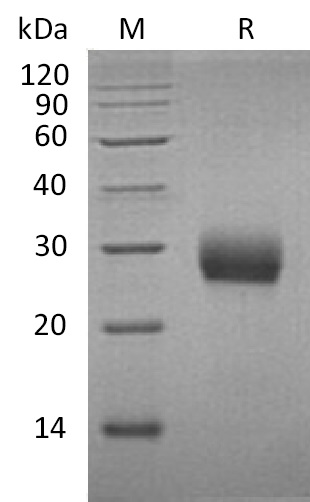 Your shopping cart is currently empty
Your shopping cart is currently empty
RANK/TNFRSF11A Protein, Mouse, Recombinant (His)
Receptor activator of NF-κB(RANK,TNFRSF11A) belongs to one member of tumor necrosis factor receptor family.It is a receptor for TNFSF11/RANKL/TRANCE/OPGL. This gene encodes a type 1 membrane protein with a 30 amino acids (aa) signal peptide, 184 aa extracellular region , a 20 aa transmembrane domain and a 391 aa cytoplasmic region. Human and murine RANK share 81% aa identity in their extracellular domains. RANK is ubiquitous highly expressed in trabecular bone, thymus, small intestine, lung, brain and kidney, but weakly expressed in spleen and bone marrow. After binding its ligand RANKL, RANK can activate signaling pathways such as NF-κB, JNK, ERK, p38, and Akt/PKB, through TRAF protein phosphorylation. RANK/TNFRSF11A signaling is largely considered to be growth promoting and apoptosis reducing such as the effects observed in osteoclasts. RANK/TNFRSF11A was also found to be involved in the regulation of interactions between T-cells and dendritic cells.

RANK/TNFRSF11A Protein, Mouse, Recombinant (His)
| Pack Size | Price | USA Warehouse | Global Warehouse | Quantity |
|---|---|---|---|---|
| 5 μg | $72 | 7-10 days | 7-10 days | |
| 10 μg | $116 | 7-10 days | 7-10 days | |
| 20 μg | $176 | 7-10 days | 7-10 days | |
| 50 μg | $310 | 7-10 days | 7-10 days | |
| 100 μg | $532 | 7-10 days | 7-10 days | |
| 200 μg | $919 | 7-10 days | 7-10 days | |
| 500 μg | $1,900 | 7-10 days | 7-10 days | |
| 1 mg | $2,730 | 7-10 days | 7-10 days |
Product Information
| Biological Activity | Activity has not been tested. It is theoretically active, but we cannot guarantee it. If you require protein activity, we recommend choosing the eukaryotic expression version first. |
| Description | Receptor activator of NF-κB(RANK,TNFRSF11A) belongs to one member of tumor necrosis factor receptor family.It is a receptor for TNFSF11/RANKL/TRANCE/OPGL. This gene encodes a type 1 membrane protein with a 30 amino acids (aa) signal peptide, 184 aa extracellular region , a 20 aa transmembrane domain and a 391 aa cytoplasmic region. Human and murine RANK share 81% aa identity in their extracellular domains. RANK is ubiquitous highly expressed in trabecular bone, thymus, small intestine, lung, brain and kidney, but weakly expressed in spleen and bone marrow. After binding its ligand RANKL, RANK can activate signaling pathways such as NF-κB, JNK, ERK, p38, and Akt/PKB, through TRAF protein phosphorylation. RANK/TNFRSF11A signaling is largely considered to be growth promoting and apoptosis reducing such as the effects observed in osteoclasts. RANK/TNFRSF11A was also found to be involved in the regulation of interactions between T-cells and dendritic cells. |
| Species | Mouse |
| Expression System | HEK293 Cells |
| Tag | C-6xHis |
| Accession Number | O35305 |
| Synonyms | tumor necrosis factor receptor superfamily member 11A,TRANCER,TRANCE receptor,TRANCE R,TNFRSF11A,Receptor activator of NF-KB,Osteoclast differentiation factor receptor,ODFR,NFKB activator,CD265 antigen,CD265 |
| Amino Acid | Val31-Ser214 |
| Construction | Val31-Ser214 |
| Protein Purity | Greater than 95% as determined by reducing SDS-PAGE. (QC verified)  |
| Molecular Weight | 26-30 KDa (reducing condition) |
| Endotoxin | < 0.1 ng/µg (1 EU/µg) as determined by LAL test. |
| Formulation | Lyophilized from a solution filtered through a 0.22 μm filter, containing PBS, pH 7.4. |
| Reconstitution | Reconstitute the lyophilized protein in distilled water. The product concentration should not be less than 100 μg/ml. Before opening, centrifuge the tube to collect powder at the bottom. After adding the reconstitution buffer, avoid vortexing or pipetting for mixing. |
| Stability & Storage | Lyophilized powders can be stably stored for over 12 months, while liquid products can be stored for 6-12 months at -80°C. For reconstituted protein solutions, the solution can be stored at -20°C to -80°C for at least 3 months. Please avoid multiple freeze-thaw cycles and store products in aliquots. |
| Shipping | In general, Lyophilized powders are shipping with blue ice. Solutions are shipping with dry ice. |
| Research Background | Receptor activator of NF-κB(RANK,TNFRSF11A) belongs to one member of tumor necrosis factor receptor family.It is a receptor for TNFSF11/RANKL/TRANCE/OPGL. This gene encodes a type 1 membrane protein with a 30 amino acids (aa) signal peptide, 184 aa extracellular region , a 20 aa transmembrane domain and a 391 aa cytoplasmic region. Human and murine RANK share 81% aa identity in their extracellular domains. RANK is ubiquitous highly expressed in trabecular bone, thymus, small intestine, lung, brain and kidney, but weakly expressed in spleen and bone marrow. After binding its ligand RANKL, RANK can activate signaling pathways such as NF-κB, JNK, ERK, p38, and Akt/PKB, through TRAF protein phosphorylation. RANK/TNFRSF11A signaling is largely considered to be growth promoting and apoptosis reducing such as the effects observed in osteoclasts. RANK/TNFRSF11A was also found to be involved in the regulation of interactions between T-cells and dendritic cells. |
Dose Conversion
Calculator
Tech Support
| Size | Quantity | Unit Price | Amount | Operation |
|---|

Copyright © 2015-2026 TargetMol Chemicals Inc. All Rights Reserved.



